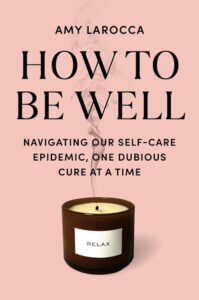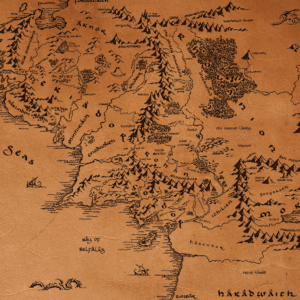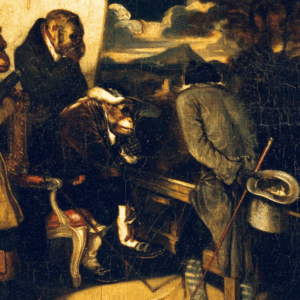
Defeating Death: On the Motivations and Methods of People Who Want to Live Forever
Amy Larocca Explores Some of the Most Extreme Manifestations of Contemporary Wellness Culture
At one point while researching How to Be Well, I traveled to a small city in the Emilia-Romagna region of Italy to attend the Global Wellness Summit. The GWS, as it’s known, was cofounded in 2007 by a woman named Susie Ellis who has the pert-nosed blond looks of a 1950s surf movie heroine. “Don’t you know about Susie?” another attendee whispered one day at the conference as we listened to Ellis, so fit in a pair of trim leather trousers, introduce another speaker. I had traveled all this way to the conference, but I knew very little about its founder. The story goes like this: Ellis and her identical twin sister first appeared on the scene as aerobics teachers at the Golden Door destination spa in California during the Lycra-wrapped 1970s and 1980s.
In 1995, Ellis eventually left to open and work as the director of the first-ever spa at Mar-a-Lago alongside her good friend Marla Maples (Ellis was, I was told, behind the scenes while Donald Trump gave a televised tour of the spa, urging him to endorse the body wraps). Next stop was investing in a website called Spafinder.com, where her job was exactly what it sounds like. As the industry expanded into this wild thing called wellness, Ellis expanded, too, ultimately becoming chair and CEO of the Global Wellness Institute, a nonprofit that employs researchers to document the weird world of wellness and also hosts an annual summit, which is a place where you can find the great pooh-bahs of the spa industry, but also a former surgeon general of the United States speaking about the possibility of ending disease. Like, all preventable disease.
The conference travels around the world (Singapore, Qatar, Palm Beach); Emilia-Romagna was chosen that year because Technogym, which is one of the world’s biggest makers of treadmills and elliptical machines, has a large corporate village complete with high-ceilinged meeting spaces and showrooms there and it’d offered to host, not least because the company’s founder had long worked on an initiative to transform Romagna into “the Wellness Valley.”
They looked happy enough and healthy enough, but not one of them looked as if she had found the fountain of youth.
In Italy, fetishism for the Italian way of life—for the natural ingredients featured in the big meals eaten with family in beautiful places—was rampant, even as it was impossible to find fresh fruits and vegetables in the gray off-season beach town near Cesena where we stayed, even as packaged gluten-free grissini adorned the tables at the summit’s crowning black-tie gala event. At one point, during a pasta-making demonstration, one attendee asked a translator if dried pasta is even available in Italian supermarkets at all, or if all Italian women roll it out like this every night.
The vast range of the conference’s topics seemed, like the trajectory of Ellis’s career, an apt metaphor for the wellness movement itself. Panels about CBD were well attended. At lunch you could find yourself next to that former surgeon general of the United States, or next to a PR person from a global hotel chain looking to increase “wellness offerings,” or you might find yourself next to someone who teaches at a school of cosmetology close to the Cape of Good Hope. At one point, I attended a baffling presentation on something called the Wellness Moonshot, which is an aspirational campaign to end all chronic, preventable disease in the whole entire world, and then the following night I went to what was billed as the world’s first-ever wellness fashion show, where dozens of models in spandex and sneakers walked a long catwalk in the gardens of an elaborate seaside hotel.
The GWS is a jolly, well-intentioned, and often confusing event, so it was a great representation of the wellness world at large, where the solid is so often chased by the silly, and good intentions, health, and capitalism are all rolled up into an only semi-coherent, nice-smelling ball. Sometimes I found myself looking around and thinking, Well, here they all are, the wellness experts! And then feeling disappointed that they look like people. Much like the senior meditators I’d met on the final day of my meditation course, these just looked like a bunch of regular old, if carefully groomed, people; some were fat, some were thin, some with frizzy, dull hair, some with sunspots, and so on. Where are all the Benjamin Buttons? I wondered. Where are the well women? At one point I stared out a window at a group of people wearing big headphones, dancing on a patio, participants in midday silent discotheque. They looked happy enough and healthy enough, but not one of them looked as if she had found the fountain of youth. Who knows? I told myself as I walked into a lecture on the future of diet delivery services. Maybe they’re all 106.
The most popular speaker of the week was Dan Buettner, the author of a series of bestselling books on longevity called The Blue Zones. Buettner is handsome and tan and charismatic; he wears his shirts a little extra unbuttoned, and he peppers his talk with irreverent jokes. He has spent the past twenty years studying Blue Zones, which is the name he gave to areas of the world where people tend to live the longest with the lowest incidence of chronic disease. Buettner has worked with a big team of demographers to identify these regions, and then to apply a microscope to the people who live in them. What do they eat? How much do they sleep? How do they get so old and stay so well? What united this disparate collection of people was the desire to juice a little extra out of life, last a little longer on earth.
The first five Blue Zones identified by Buettner were a cluster of villages in Sardinia, the Okinawa islands in Japan, the Nicoya Peninsula in Costa Rica, the Greek island of Ikaria, and a community of Seventh-Day Adventists in San Bernardino County, California. These are places, Buettner writes, where people “enjoy up to a 3 times better chance of reaching 100 than we do.” He told us the story of an immigrant who achieved the American dream—suburban house, car, good job—but was diagnosed with terminal lung cancer. He decided to spend the six months his American doctors told him were all he had left back home in Ikaria, where he started drinking the wine and chatting with his friends and going to church, and now that whole American cancer thing is a charming anecdote recounted by a proud centenarian.
The Blue Zone communities all sound like what the German Lebensreformers were lamenting: simple, earthbound lives, defined by community and a low-level interference from the rest of the too-modern world. (What Buettner doesn’t dwell on is that these are largely homogeneous communities.) Buettner’s audiences listen, eager not to die of cancer like that zillion-year-old Greek man, to be happy and well at a hundred and beyond by joining and implementing the rules of the “Blue Zones Project,” whereby Buettner sells tools and plans to communities eager to become the Blue Zones of tomorrow. He also sells a Blue Zone meal plan that includes “thousands of recipes inspired by the traditions of the world’s longest lived people,” like Adventist Rice Salad and Okinawan Cream of Mushroom Soup.
Because longevity, and even immortality, are the natural end points for all of wellness. And not just living forever but living forever with a tight ass and the springy energy of freshman year, extended in perpetuity.
*
Many of the biohackers are aspiring immortals. Dave Asprey says he’ll live to 180 (“at least, I don’t want to limit myself,” he told me) and that if he and his physician wife decide to have another round of kids in their eighties, well, why not? Who would carry them? I ask.
“Well, she would,” he says, “or I would if I want to.” So we await the possibility of low-mold-coffee Dave becoming the world’s first eighty-five-year-old pregnant man.
The tech supermen are also on board for defeating death, of course. Sergey Brin, the Google cofounder whose ex-wife cofounded the genetic testing company 23andMe, learned thereby that he had a genetic predisposition to developing Parkinson’s disease. Five years later, Google invested $1 billion to launch a secretive company called Calico—short for California Life Company—which focuses on longevity research. Jeff Bezos is one of the investors in Unity, a longevity biotech company led by a middle-aged man named Ned David whose youthful looks perhaps convince investors of the efficacy of his approach. One start-up founder told The New Yorker’s Tad Friend, “The proposition that we can live forever is obvious. It doesn’t violate the laws of physics, so we will achieve it.”
There’s a doctor who runs a hedge fund in California named Joon Yun whose interest is in preserving not only the length but also the quality of life. Both, he believes, are infinitely possible in a healthy person—“There is no difference between longevity and wellness,” he told me—and then he offers a, to me, perfect definition of wellness: it is nothing. It’s just a feeling of peace so complete that the feeling itself disappears. Wellness is the absence of irritation, a feeling of lightness and ease, both mental and physical. It is sleep that comes when the lids first close and lasts—deep and black—exactly as long as you need. It is waking up sparkling, ready, refreshed. It is a body free from aches, pains, scars. If you are truly well and you trip and fall, you’ll soon be up again, and any pain, discomfort, or embarrassment will recede swiftly and completely. A perpetual life machine.
Recently, tabloids, but also the mainstream press, have enjoyed telling the story of a California man named Bryan Johnson who sold an online payment company he’d founded and upon netting $300 million decided to spend some large portion of that on his physical self. Not only does he want to live forever, but he wants to reverse his biological age. In 2023 he was forty-five in chronological years but spending all day every day attempting to nudge any measurable quantifiers of his health to match those of a typical teenage boy. He was also spending around $2 million a year on the effort and taking 111 pills a day. It “has produced near perfect health for me,” he says proudly. He’d injected himself with his teenage son’s blood plasma, but stopped after detecting no measurable benefit.
*
Back at the Global Wellness Summit, Dan Buettner was ready to reveal the secrets of his long-lived Blue Zones. But first he asked the audience to respond to eight questions:
Raise your hand if…
You sleep at least seven hours a night.
You move for at least thirty minutes a day.
You eat three honest servings of vegetables every day.
You have not had unprotected sex with a stranger (“I want to party with you guys tonight!”).
You belong to a faith, and keep your hand up if you show up at least four times a month.
You have at least three friends who you can have a meaningful conversation with, call on a bad day and they’d care, and you actually like.
You have not smoked tobacco in the last five years.
You have the desire and the physical capacity to live to the age of ninety.
The closer you got to eight “yes” answers, the more well you are, Buettner explained. There are no potions or tablets or saunas or steams that matter, and “no matter where you go in the world and you see long-living people, it’s not because they tried. They never said at age fifty, ‘I’m going to get on that longevity diet and live another fifty years,’ ” he said. “They didn’t join the wellness program at work; they didn’t call up a 1-800 number and start ordering supplements. The big epiphany here is that longevity is not something that is successfully pursued.”
I watched the shoulders of a woman I’d just seen on a panel discussion on corporate wellness slump. When I’d wandered into the room where she’d been speaking an hour earlier, she was imploring her audience, “But how do you get people to come?” I, great ignorer of HR emails, slinked out the back and went to another talk about CBD. And now here we all were, the surgeon general and the facialist and the architect interested in the healing powers of light, and none of it mattered at all. Living a long, healthy, beautiful life, we were being told, is not something that can be taught or bought or even meaningfully pursued. Everyone liked Dan Buettner, but it was hard not to feel a little silly if you’d just spent a few hundred bucks on probiotics and adaptogens and then watched a slideshow starring a 105-year-old Adventist who would never do that and who still bikes to her volunteer job at an old-folks home (ba-dum-bum).
Most of the women I know do not actually want to live forever. Not on this earth, not in the ether or the cloud or anywhere else.
Buettner had entered his project with mixed expectations, keeping in mind a report issued by fifty-one of the world’s top longevity experts in 2002 that read: “Our language on this matter must be unambiguous. There are no lifestyle changes, surgical procedures, vitamins, antioxidants, hormones, or techniques of genetic engineering available today that have been demonstrated to influence the processes of aging.” Even with this “there are no secrets” answer, he would still go on to write four bestselling books, still travel the world delivering this “raise your hand” speech (sometimes as a TED talk) to eager people who sit, with pens poised above notebooks, smiling at the story of an elderly cancer-beating Greek.
I took a quiz on the Blue Zones website that told me that, given my current habits, I’m on track to live to 91.8, but that I could, using Blue Zone methodology, make it to 97.4. The free advice was to sleep more, drink red wine, be friendlier (“It may not surprise you to hear that a new friend can help you live longer, but did you know friends can be worth $134,000 of happiness?”), find faith (all but 5 of the 263 centenarians studied by the Blue Zone team described regular, faith-based practices), and improve my attitude. That last bit was generated when I’d admitted to feeling stress, anger, and sadness in the previous thirty days on the questionnaire. Some of the advice was accompanied by articles like “5 Rules for Building True Friendships” that I could read for free. If I wanted other advice, like the Blue Zones guide to better sleep, I’d have to pay, and I didn’t want to pay. Also, my Modern Age clinic evaluation had told me—even before I subjected myself to an hour-long vitamin drip—that my physical age is three years younger than my chronological age. So maybe this means I’m on track to live to 94.8, anyway, and certainly that’s plenty?
*
The biohacked body and mind are not unlike cryptocurrency: a great big bet on an unknowable future. We see biohacked people with their shirts off, with abs ripped well past the point where one might reasonably expect such a thing, and determine that biohacking is working for them. When meditators swear by their meditations, attributing Super Bowl wins and mega-celebrity and extreme corporate and business successes to the practice, such a practice begins to seem unassailable. Its benefit is suggested in each of my meditation instructor’s tinkly giggles, in the ever-friendly squinting of his nicely crinkled eyes.
But there is not yet evidence on the big stuff, on whether and to what extent it is possible to improve upon the general level of health that affluence in America can afford. We know that some level of privilege, access, and vigilance can prevent the worst outcomes, but we don’t yet understand what these “better” outcomes might look like. When I open my eyes at the end of a meditation, I have not transcended. I am still in the small purple chair in my room, the facts of my life unmoved by my effort. My fellow meditators seem much the same: regular people just trying to make it through another day.
Most of the women I know do not actually want to live forever. Not on this earth, not in the ether or the cloud or anywhere else. What women tend to want, I’ve found, is to live for a good long while in a suspended state. Immortality just seems…exhausting.
The grand finale of my meditation class was a big group session with previous graduates. Michael Miller, our teacher, threw open the doors to the gallery, and the meditators flooded in. They didn’t look particularly optimized, not like corporate raiders, or like celestial beings, or like anything really but a pretty random cross section of the types of people one sees around New York in the hours when work wraps up: well-intentioned working people, not hippies, just people. Tired from the struggle, the schlep. As everyone sat there, eyes closed, foreheads gently furrowing, it felt hard to be cynical or skeptical about a roomful of people so hungry for a moment of stillness and peace. Are we really all trying to take over the world? Or has the endlessly aggressive selling of it all obscured the most basic and simple fact that we are all, ultimately, just looking for a tiny bit of peace.
__________________________________

From How to Be Well: Navigating Our Self-Care Epidemic, One Dubious Cure at a Time by Amy Larocca. Copyright © 2025. Available from Alfred A. Knopf, an imprint of Knopf Doubleday Publishing Group, a division of Penguin Random House, LLC.
Amy Larocca
Amy Larocca is an award-winning American journalist. She spent 20 years working at New York magazine as both Fashion Director and Editor at Large. Her writing has appeared in the New York Times, Vogue, Town & Country and the London Review of Books, among others. She lives with her family in New York and North London.












